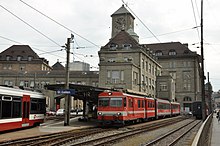Diameter line
As a diameter line (also pass line ) is defined as a center through the extending therethrough from a district A to a district B continuous line of public transport . This can be rail transport ( regional , suburban , underground , tram , light rail lines ) or bus, trolleybus lines. Since bus traffic that is not tied to specific rail routes allows more freedom of action, there is a greater variety of line network models in this area (for example star-shaped city networks or line branches with ring service at end points).
features


With diameter lines, compared to lines with a final destination in the center of the town, additional possibilities for public transport can be created. If you have to change at a central bus stop in the center of the city when traveling from A to B, journeys beyond the transfer point close to the center become difficult and time-consuming. A change means always looking for new orientation (for example the right departure stop), additional effort and hardship (especially for passengers with luggage or strollers, elderly, disabled people), fear of being lost due to delays and loss of time of at least five minutes. A continuous line offers problem-free journeys even from a starting point a few stops in front of a central stop to another nearby stop in the center.
Special local situations, such as a train station outside the town center, even make continuous lines an absolute necessity, because otherwise a large number of rail passengers would have to change trains again in local bus traffic, which would significantly reduce the attractiveness of the offer. Similar situations are also found in shopping centers, medical care facilities and the like that are remote from the center. Ä. given.
In tariff systems with short-haul tariffs without the right to transfer to other transport lines, continuous lines also enable additional usage options: The cheaper tariff then applies beyond the central connection point .
Continuous lines do not need parking and turning spaces in the town center, where space is expensive and often in short supply. A point that has recently been viewed as a disadvantage, the same line numbers in two directions, can be solved by merging line branches. The city bus in Rheine offers a good example of this: a star-shaped network of lines with separate line names for all branches, with two lines being continuously combined (also visible in the network and timetables).
The through station at Stuttgart main station , which is currently under construction in the course of Stuttgart 21, is also intended to connect lines that have started and ended in the station.
See also
- Diameter line Altstetten – Zurich HB – Oerlikon of the Swiss Federal Railways
- Railway line Appenzell – St. Gallen – Trogen , diameter line of the Appenzeller Bahnen (AB)